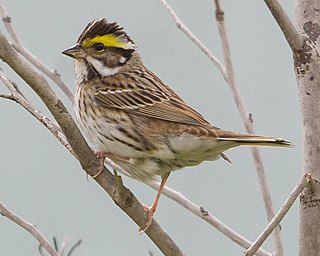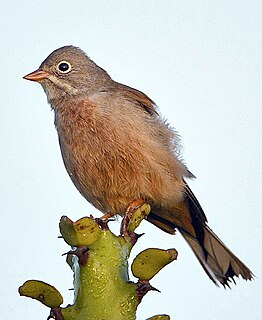
The common reed bunting is a passerine bird in the bunting family Emberizidae, a group now separated by most modern authors from the finches, Fringillidae. The genus name Emberiza is from Old German Embritz, a bunting. The specific schoeniclus is from Ancient Greek skhoiniklos, a now unknown waterside bird.

Pallas's reed bunting, also known as Pallas's bunting, is a passerine bird in the bunting family Emberizidae, a group now separated by most modern authors from the finches, Fringillidae.

The corn bunting is a passerine bird in the bunting family Emberizidae, a group now separated by most modern authors from the finches, Fringillidae. This is a large bunting with heavily streaked buff-brown plumage. The sexes are similar but the male is slightly larger than the female. Its range extends from Western Europe and North Africa across to northwestern China.

The cirl bunting, , is a passerine bird in the bunting family Emberizidae, a group now separated by most modern authors from the finches, Fringillidae.

The pine bunting is a passerine bird in the bunting family Emberizidae, a group most modern authors now separate from the finches, Fringillidae. It lives in Eurosiberia east of the Urals.

The rustic bunting is a passerine bird in the bunting family Emberizidae, a group now separated by most modern authors from the finches, Fringillidae. The genus name Emberiza is from Old German Embritz, a bunting. The specific rustica is Latin for "rustic, simple".

The yellow-breasted bunting is a passerine bird in the bunting family Emberizidae that is found across the Boreal and East Palearctic. The genus name Emberiza is from Old German Embritz, a bunting. The specific aureola is Latin for "golden". The bird's call is a distinctive zick, and the song is a clear tru-tru, tri-tri.

The yellow-browed bunting is a passerine bird in the bunting family Emberizidae, a group now separated by most modern taxonomists from the finches (Fringillidae). The genus name Emberiza is from Old German Embritz, a bunting. The specific chrysophrys is from Ancient Greek khrusophrus, "golden-browed".

The black-faced bunting is a passerine bird in the bunting family Emberizidae, a group now separated by most modern authors from the finches, Fringillidae.

Cretzschmar's bunting is a passerine bird in the bunting family Emberizidae, a group now separated by most modern authors from the finches, Fringillidae.

The black-headed bunting is a passerine bird in the bunting family Emberizidae. It breeds in south-east Europe east to Iran and migrates in winter mainly to India, with some individuals moving further into south-east Asia. Like others in its family, it is found in open grassland habitats where they fly in flocks in search of grains and seed. Adult males are well marked with yellow underparts, chestnut back and a black head. Adult females in breeding plumage look like duller males. In other plumages, they can be hard to separate from the closely related red-headed bunting and natural hybridization occurs between the two species in the zone of overlap of their breeding ranges in northern Iran.

The rock bunting is a passerine bird in the bunting family Emberizidae, a group now separated by most modern authors from the finches, Fringillidae.

The red-headed bunting is a passerine bird in the bunting family Emberizidae, a group now separated by most modern authors from the finches, Fringillidae.

The Cape bunting is a passerine bird in the bunting family Emberizidae.

The golden-breasted bunting is a passerine bird in the bunting family Emberizidae. It occurs in dry open woodlands and moist savanna in Africa south of the Sahara, but is absent from the equatorial forest belt.

The striolated bunting is a passerine bird in the bunting family Emberizidae, a group now separated by most modern authors from the finches, Fringillidae.

The yellow bunting or Japanese yellow bunting is a passerine bird of eastern Asia in the bunting family Emberizidae. It is threatened by habitat loss, the use of pesticides and trapping for the cagebird industry.

The meadow bunting or Siberian meadow bunting is a passerine bird of eastern Asia which belongs to the genus Emberiza in the bunting family Emberizidae.

The chestnut bunting is a passerine bird in the bunting family Emberizidae found in the East Palearctic.

The grey-necked bunting, sometimes referred to as grey-hooded bunting is a species of bird in the family Emberizidae. It breeds along a wide distribution range from the Caspian Sea to the Altai Mountains in Central Asia and winters in parts of Southern Asia. Like other buntings it is found in small flocks.





















